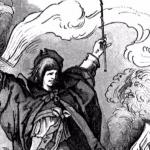For the last fifteen years many of my Yule rituals have involved an invocation to Santa Claus. I’m not sure old Kris Kringle is a god exactly, but he’s certainly a powerful figure, and is treated much like a deity. I think he represents a lot of what Yuletide is about, and his image and myth connect me to this time of year much more powerfully than babies being born in caves or staying up until dawn to watch the rising sun.
But there’s another figure that connects me to Yuletide, and his myth and his presence is on the upswing. I don’t think the Krampus ever really left the Holiday Season, but for awhile we didn’t properly articulate (and appreciate) the messenger.

The Horned God is a complicated piece of Modern Mythology. Certainly in the Ancient World there were horned and antlered gods (and the Krampus could be related to one), but the larger composite Horned God many of us know is a rather modern interpretation. I’m not telling you that the Krampus is the Horned God of Yule, but he certainly can be, because he’s much like other reflections of the Horned God.
The Krampus Lives Between the Worlds
Thew word liminal is a popular one in Witchcraft and Pagan circles, and for good reason. Those of us who practice between the worlds most certainly occupy liminal spaces, and the Krampus is no different. Unlike Santa Claus (whose mythology is much more extensive) we don’t know where the Krampus resides outside of the holiday season, but it’s most likely not in anyone’s town or village. If I had to harbor a guess I’d say he probably lives out in the wild away from civilization.
This makes the Krampus much like the Greek God Pan, another horned figure who existed in the liminal between civilization and the wild. Pan never particularly cared for all the trappings of civilization, but he liked some of what it offered, especially wine. I’d put good money on the Krampus being a drinker, but we know with some certainty that he enjoys primitive weaponry, woven baskets, and on at least some occasions, is a pretty snappy dresser. Those things are all benefits that come from civilization.
Civilization is also about order, and the Krampus is most certainly a lover of order. His job is to maintain order by scaring children into behaving properly. He shows up in December and reminds the little ones not to stray too far outside what is acceptable. In some versions of his myth he puts the naughty children in his basket backpack and whisks them away to the Christian Hell. (With all the fur he has on his body I think we can be relatively certain he doesn’t live there.) The Krampus doesn’t make very many forays into the industrialized world, but when he does they are purposeful and brief.

The Krampus is Sexual and Debaucherous
With his long tongue and leering eyes the Krampus comes across as an extremely sexual deity, much like more familiar representations of the Horned God. Many vintage postcards featuring Krampus look more like Valentine’s Day greetings than Christmas cards, and the ladies who catch his eye always look be smitten by his attentions.
Though it’s not thought of as much of a sexual holiday today, Yuletide has long had sexual overtones. Medieval Lords of Misrule often hooked up with “temporary wives” for celebratory (and often drunken) sex, and Christmas parties have long contained sexual undertones.
Besides, think of what the world was like 600 years ago during the heyday of the Krampus. The days were short and cold, and heavy snows limited what people could do outside. In other words, what else is there to do other than fornicate? December is the most fertile month of the year, so we know people are doing it around the Holidays. It makes sense that such feelings would be conceptualized by some sort of Yuletide deity.

Apollonian and Dionysian
Yuletide has always been a time of two rather different and contradictory world-views. The first can be summed up in the Santa Claus/Saint Nicholas myth. In that version of Yule, the holidays are about religious piety, giving, family centered celebrations, and quiet reflection. In this version of the season, Christmas is the pinnacle of religious thought and expression and is thought to bring out the best in humanity.
There is nothing wrong with this more reasoned approach to the holidays. The Winter Solstice can most certainly be a time for quiet reflection, and we see an uptick in charitable donations and genuine goodwill this time of year. Here Santa Claus is much like Apollo, providing order, and shining as a star in the Midwinter darkness.
On the other side of the equation though lies the Krampus, who represents an alternative version of Yuletide. He’s the drunken office Christmas party, the dance at Fezziwigs, and the drunken sing along to Auld Lang Syne. Santa Claus is the somber Christmas carol while the Krampus is the naughty kiss under the mistletoe. Both are an equal, and necessary, part of the holiday season.
Santa is most certainly a “right jolly old elf,” but he’s not naughty. Krampus is naughty, and naughtiness is important. It allows us to release the pressure that comes with living in a civilized society. Drunken Yuletide is a social safety valve, it’s when we get to tip the apple cart (but not necessarily knock it over).
No matter how you celebrate the Season, be sure to make a little bit of time for the Krampus!

















